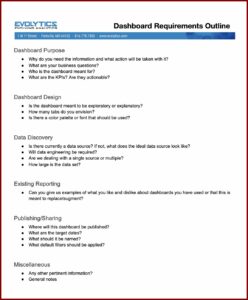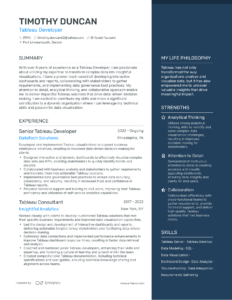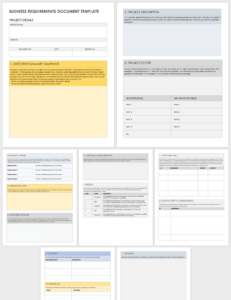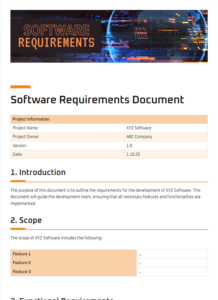Creating a dashboard requirements document is a crucial step in ensuring that your dashboard project is successful. This document serves as a roadmap for the development team, outlining the specific requirements and expectations for the dashboard. By clearly defining the requirements upfront, you can minimize the risk of misunderstandings, delays, and costly rework.
A well-structured dashboard requirements document should include the following key sections: project overview, stakeholder needs, data sources, dashboard functionality, user interface, and acceptance criteria. Each section should provide detailed information on the specific requirements for that aspect of the dashboard.
What to Include in a Dashboard Requirements Document Template?
The content of a dashboard requirements document template will vary depending on the specific project, but there are some common elements that should always be included. These include:
- Project overview: This section should provide a brief description of the project, including the project goals, objectives, and scope.
- Stakeholder needs: This section should identify the stakeholders who will be using the dashboard and their specific needs. It is important to consider the different roles and responsibilities of each stakeholder, as well as their level of technical expertise.
- Data sources: This section should list the data sources that will be used to populate the dashboard. It is important to provide details on the format of the data, the frequency of updates, and any data quality issues that need to be addressed.
- Dashboard functionality: This section should describe the specific functionality that the dashboard will provide. This includes the types of visualizations that will be used, the drill-down capabilities, and any interactive features.
- User interface: This section should describe the user interface of the dashboard. This includes the layout of the dashboard, the color scheme, and the overall look and feel.
- Acceptance criteria: This section should define the criteria that will be used to determine whether the dashboard meets the requirements. This may include factors such as accuracy, performance, and usability.
Benefits of Using a Dashboard Requirements Document Template
There are many benefits to using a dashboard requirements document template. These benefits include:
- Improved communication: A well-crafted dashboard requirements document template can help to improve communication between stakeholders and the development team. By clearly defining the requirements upfront, everyone involved in the project can have a clear understanding of what is expected.
- Reduced risk: A dashboard requirements document template can help to reduce the risk of project delays and costly rework. By identifying and addressing potential issues early on, you can avoid problems down the road.
- Increased efficiency: A dashboard requirements document template can help to increase the efficiency of the development process. By providing a clear roadmap, the development team can work more efficiently to create a dashboard that meets the needs of the stakeholders.
- Improved quality: A dashboard requirements document template can help to improve the quality of the final product. By clearly defining the requirements, you can ensure that the dashboard meets the needs of the stakeholders and is of high quality.
Conclusion
A dashboard requirements document template is an essential tool for any dashboard project. By clearly defining the requirements upfront, you can improve communication, reduce risk, increase efficiency, and improve quality. If you are planning to develop a dashboard, be sure to use a dashboard requirements document template to get started.
With a well-structured dashboard requirements document template, you can ensure that your dashboard project is successful and that you deliver a product that meets the needs of your stakeholders.



